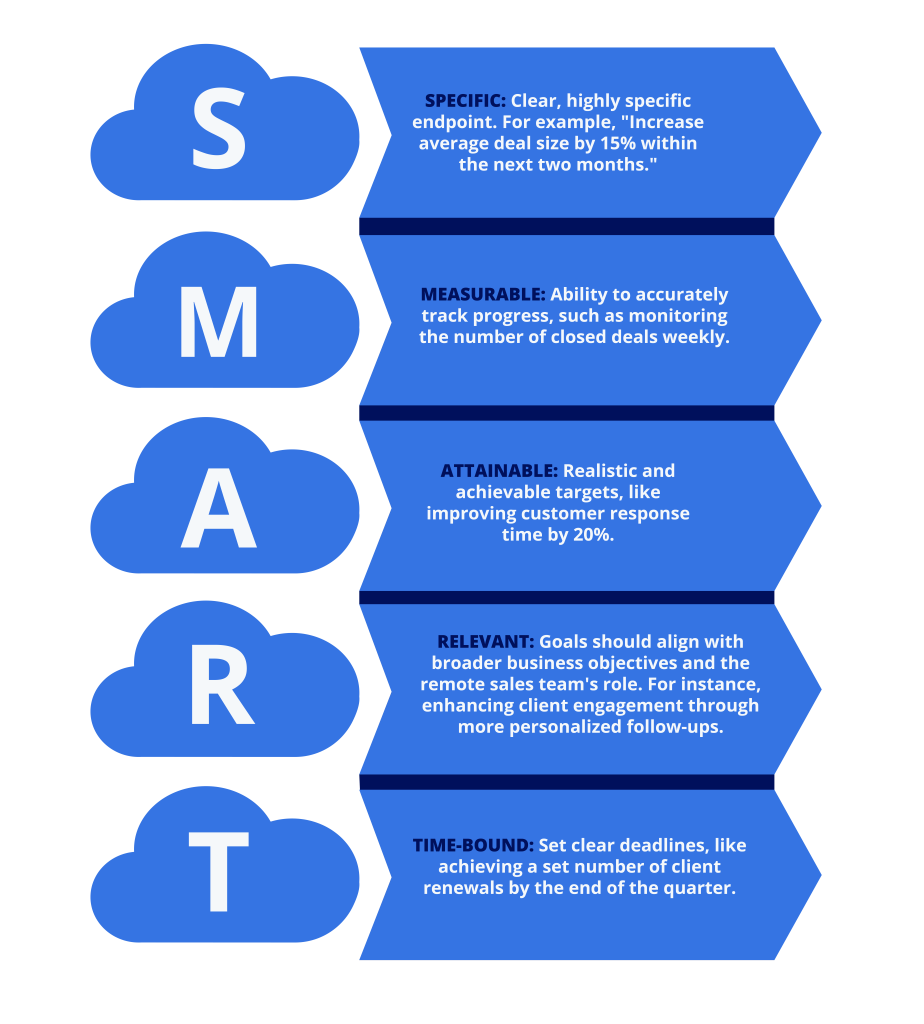The trend of remote work is increasing, but remote sales performance faces challenges.
According to the 2019 HubSpot Remote Work Report, sales professionals who work remotely often experience a sense of disconnection and encounter communication issues, which ultimately affect their sales performance. This can be difficult for salespeople who heavily rely on social interaction to effectively carry out their jobs.
However, remote work doesn’t have to mean decreased sales productivity. To make sure sales teams succeed while working remotely, it’s important to choose the right performance metrics.
In this blog, we will be discussing the key metrics for evaluating the remote sales performance teams and best practices to overcome obstacles to maximize their potential.
Set Clear Goals for your Remote Sales Team
To lead your remote sales team to success, it’s important to set clear and achievable goals.
Start by identifying specific goals based on your team’s needs and abilities. Be clear and avoid any confusion during this process by being specific and ensuring that everyone understands what is expected of them.
The SMART strategy is a useful tool to help you outline your objectives in a clear, concise, and actionable manner. By following this strategy, you can create goals that are Specific, Measurable, Achievable, Relevant, and Time-bound.
Here’s a summary of SMART Goals for Remote Sales Teams:

Essential Metrics for Remote Sales Performance
Call Volume
In remote sales, call volume is a critical metric. It measures the number of calls each sales rep makes, providing insight into their activity level and dedication to reaching out to potential clients.
High call volumes often correlate with increased opportunities to move through the sales process.
Tracking Tip: Use call tracking software to automatically log calls made by each rep. Set up daily or weekly reporting to monitor and compare call volumes.
Closed-Won Deals Per Rep
Tracking closed-won deals gives a clear picture of each rep’s performance against their quotas. This metric is particularly valuable for remote teams, as it offers a direct view of sales effectiveness.
Comparing closed-won deals with call volume can also highlight the efficiency of phone activities in generating sales.
Tracking Tip: Implement a CRM system to record and track closed-won deals. Regularly review these metrics in team meetings to assess performance and set benchmarks.
Revenue Generated Per Rep
This goes beyond just the number of deals closed, focusing on the actual revenue each sales rep brings in. It’s essential for understanding the impact of each rep on the company’s bottom line, especially in terms of high-value sales, which are critical for business growth.
Tracking Tip: Use your CRM to track the revenue associated with each closed deal. Analyze this data to understand which reps are generating higher-value sales.
Outreach Activities
To achieve success in remote sales performance, it is essential to evaluate the effectiveness of outreach activities. Remote sales teams can track the number of new opportunities added to the pipeline and the follow-up rate with leads.
By doing so, they can assess the efficiency of their prospecting techniques and adjust their strategies accordingly to meet quarterly and annual goals.
Tracking Tip: Monitor activities like emails sent, LinkedIn messages, and cold calls. Use CRM or sales engagement platforms to track these activities and measure their impact on the sales pipeline.
Sales Tools Used Per Rep
The efficiency and productivity of a sales rep can be greatly influenced by the quantity and nature of tools they use.
Regarding remote sales teams, choosing the appropriate technology is crucial for collaborating with colleagues and communicating with international clients. By regularly evaluating the tools that are employed and their efficacy, the sales process can be optimized, leading to better results.
Tracking Tip: Conduct periodic audits of the tools each sales rep uses. Gather feedback on tool effectiveness and usage to ensure optimal technology stack for your team.
Leads Generated From Various Channels
Knowing where leads come from is essential for remote sales teams.
By figuring out the best ways to generate leads, such as using social media, sending emails, or connecting online, remote sales teams can create strategies that give them the most high-quality leads.
Tracking Tip: Tag and track leads in your CRM based on their source. Analyze this data to determine which channels are most effective for lead generation.
Percentage of Time Spent on Sales Activities
Efficiency can be improved by tracking the time spent on sales activities instead of administrative tasks.
Increased time spent on sales can raise the chances of hitting targets. A sales rep’s productivity can be significantly enhanced if non-sales activities are identified and reduced.
Tracking Tip: Have sales reps log their activities in a time-tracking tool. Review these logs to identify and reduce time spent on non-sales tasks, reallocating it to core sales activities.
Sales Rep Ramp-Up Time
It is crucial for sales teams operating remotely to grasp the time it takes for a new sales rep to attain total productivity.
Keeping track of ramp-up duration helps gauge the effectiveness of training and onboarding. Simplifying the ramp-up process can facilitate faster integration of new representatives into the team, ultimately improving overall team performance.
Tracking Tip: Set milestones for new rep development and track progress against these goals. Use feedback sessions with new reps to continually refine the onboarding process.
Best Practices for Evaluating Remote Sales Performance
To evaluate remote sales performance teams, take into consideration this comprehensive and adaptable.
Here are some essential strategies to create a cohesive evaluation plan:
1. Integrating CRM and Sales Tracking Tools
- CRM Software: Centralizes customer interactions, leads management, and monitors sales performance. It’s essential for collecting comprehensive data.
- Sales Analytics Tools: Provide real-time insights and trends, crucial for identifying opportunities and addressing issues promptly.
- Data Integration: Ensuring your CRM and analytics tools are fully integrated with other business systems guarantees data accuracy and consistency.
2. Regular Review Cycles: Daily, Weekly, Monthly
- Comparative Analysis: Regularly compare current metrics to historical data to spot trends and evaluate performance progression.
- Benchmarking: Use industry benchmarks to see how your team compares to competitors, highlighting areas for improvement.
- Segmentation: Break down data into categories (e.g., salesperson, product, location) for a more detailed performance analysis.
3. Incorporating Peer Reviews and Self-Assessments
- Root Cause Analysis: When metrics decline, investigate underlying reasons, such as training gaps, product issues, or market changes.
- Strengths and Weaknesses Identification: Analyze performance data to identify what your team excels at and where there are challenges.
4. Balancing Quantitative and Qualitative Measures
- Quantitative Data: Focuses on measurable metrics like conversion rates and sales cycle lengths.
- Qualitative Insights: Derive insights from qualitative data like customer feedback, rep engagement, and communication effectiveness.
5. Continuous Training Based on Performance Data
- Tailored Training: Address identified weaknesses and build on strengths with specific training and coaching in sales techniques, product knowledge, and objection handling.
- Ongoing Learning: Keep your team updated with the latest industry trends and skills through regular workshops and coaching sessions.
6. Update Metrics in Response to Market Changes
- Regular Strategy Reviews: Conduct frequent reviews of sales strategies to ensure they align with market trends and customer needs.
- Flexibility in Approach: Adjust strategies as needed to respond to market shifts, technological advancements, or changes in customer behavior.
7. Learn from Data: Use Past Performance to Inform Future Strategies
- Data-Driven Decisions: Use performance data to guide future sales strategies and tactics.
- Market Awareness: Stay updated on market dynamics and incorporate these insights into your strategic planning.
8. Incorporate Sales Team Feedback into Metric Evolution
- Team Input: Regularly ask for feedback from your sales team to understand on-the-ground challenges and opportunities.
- Collaborative Evolution: Use insights from your team to evolve metrics and strategies, ensuring they remain relevant and practical.
Conclusion
Remote Sales Performance measurement is the best way to stay competitive by evaluating your team regularly.
They can do this using tailored metrics based on real-time data and feedback. These metrics will help them adjust their sales strategies to meet current trends and customer needs.
To succeed in remote sales, teams must be adaptable and focus on continuous improvement. Businesses can ensure their remote sales teams are well-equipped to excel in the competitive realm of B2B sales by nurturing a culture of ongoing learning and flexibility.








